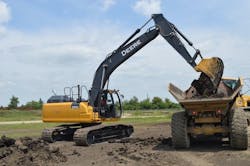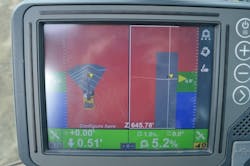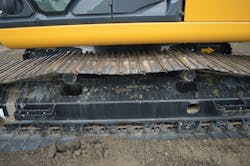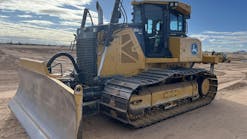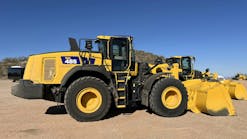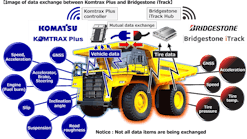“With the SmartGrade tool, we’ve made it a tool to make your job easier, but we also don’t want to limit the abilities of the operator to do what they need to do,” says Alex Anhalt, John Deere’s product consultant for excavators.
Managers can choose how deeply they want to invest in grade control solutions with the unit, and users can decide how much tech they want to apply in each job site application.
Deere’s SmartGrade technology for excavators (available on two models so far, the Deere 210G and Deere 350G) automates the boom and bucket functions for the operator to more easily achieve a smooth and accurate finish grade. Using GNSS positioning technology for accurate horizontal and vertical positioning, the machine controls boom and bucket movements to a precise design target. This lets an operator focus on controlling the arm function while the system raises and lowers the boom to maintain grade.
Deere has designed a flexible path to and through grade management that is sensitive to the needs of owners new to or growing grade-control expertise.
The company offers four grade-management options for owners: SmartGrade, SmartGrade-Ready with 2D, 3D Grade Guidance, and 2D Grade Guidance.
“We’re the only OEM that offers 2D Grade Guidance, 2D Grade Control, 3D Grade Guidance, and 3D Grade Control,” Anhalt says. “We wanted to offer different price points for every customer application. There are some contractors who are using grade control on everything, there are others who are fine doing it the way it’s always been done. You can get in with a small investment for 2D Grade Guidance, and as your business grows and your needs change, we offer field kits that can upgrade all the way to 3D control.”
What Deere SmartGrade offers
The SmartGrade-Ready with 2D option provides a 2D system with semiautomated functions, improving the ease of use without the need for GNSS technology or 3D design plans. Additionally, the SmartGrade-Ready machines arrive from the factory pre-wired for the SmartGrade system, enabling the owner to upgrade in the future. The 3D or 2D Grade Guidance options provide reference information to the operator in the cab to improve productivity, Deere says.
The 2D Grade Guidance option shares bucket tooth and cutting-edge elevation information relative to a benchmark with the operator through the in-cab monitor. The 3D Grade Guidance option accurately provides the horizontal and vertical bucket position using GNSS technology and can make use of a 3D design plan. All guidance and control options are available with an optional laser receiver, which leverages a local external elevation reference.
The 210G provided by Deere for the Field Test was equipped with the highest tier, 3D control. The system is a co-development with Topcon.
“SmartGrade is a Topcon-based solution, but we understand that contractors run many different grade-control offerings,” Anhalt says. “What’s nice about the radio [atop the excavator] is you can swap from Topcon to Trimble or Leica just by switching the radio. Take one radio off, put on another one, and it talks to another grade control OEM’s base station.”
The gray triangle on the Deere 210G in-cab monitor (above) shows the virtual fence within which the excavator is set to operate. Our professional operator had some comments below.
How well does SmartGrade perform?
On a near-perfect summer day after an early morning rain in Wilmington, Illinois, International Union of Operating Engineers Local 150 operator/instructor Dave Gottlieb settled into the 210G’s cab for ditch work, fine grading, and truck loading, with and without the various tech features switched on.
Standard technology features on the machine include controls to keep operators from going beyond established parameters—parameters that include more than simply making sure operators do not go beyond grade.
Virtual Front hydraulically limits and automatically stops the bucket cutting edge from contacting the front of the machine at a selectable distance, preventing machine damage. The over-dig protect feature limits the bucket’s cutting edge from going below the target design surface. Additional virtual fence technology features, such as Virtual Ceiling, Virtual Floor, Virtual Swing, and Virtual Wall, provide the operator with audible alerts as the machine approaches an adjustable setpoint.
Gottlieb has mixed feelings about using some of the virtual fences.
“I’m not sure how much I would use them,” he says. “Possibly a little bit. I noticed it allowed you to go into a warning zone with a beep. I suppose maybe I’d use it for a height restriction, if there were power lines above. It would just alarm the operator if he became complacent and didn’t pay attention or accidentally got near the power lines, which I’ve seen happen. This could protect from that.
“For down below you, it could be of use in a landfill for some of those liners you have to be very protective of,” Gottlieb says.
Although Gottlieb is unsure how much he would use virtual fencing after just a few hours in the machine, he’s not on the fence about grade control.
“You’re going to have to incorporate the technology because let’s face it, it’s not going anywhere,” he says. “It’s like computers in that GPS just continues to change every year. You’re either going to have to adapt or find another occupation.”
Deere has made using SmartGrade and its various features relatively easy.
“Everything is integrated into the joysticks,” Anhalt says. “The two joysticks and all the technology controls are integrated into three buttons. You can use a slider and multiple triggers to command eight different functions of the grade control. That’s a small amount of buttons for every function of the grade control and all the features.”
The 210G has pilot controls, despite industry migration to E-H controls. “E-H is fine and it gives you a lot of additional features, but when it comes to our excavator customers, they’re very finicky—they like feel,” Anhalt says. “They like to know what they’re pulling through the dirt. If they hit something, they like to feel the resistance in their hands. We kept the pilots and still added the technology because that’s what our customers wanted. And you can have feel and smooth controls running the machine even when you’re not in the ‘autos’ [automated functions].”
Gottlieb’s first task with the machine was simulating digging a ditch roughly 2.5 feet down in wet material. “It had plenty of power, and I noticed that the engine did increase rpm as I started pulling into a heavier cut, but it stayed very fluid and smooth.”
(Above) For all the technology on the excavator, Deere has not ignored the basics. Note the cut-outs under the two carrier rollers. These were designed so dirt would fall off the rollers and not remain stuck underneath to cause premature wear.
He locked the bucket in on grade. “I like that you can lock the bucket to where it’s flat, or you can lock it in at an angle,” Gottlieb says. “I found it very beneficial when you want to smooth the bottom. This will pull nice and smooth, and it won’t let the heel of the bucket go below grade or penetrate the elevation you’re trying to maintain.
“I also tried the overdig protection,” Gottlieb says. “If you don’t want to go past a certain point, it will slow you down or stop you. I can see that being beneficial in a few situations.
“Other than that, I had it off most of the time because sometimes that alarm could be a little bit annoying,” he says. “The automatic modes in SmartGrade were very smooth, and the transitions into them were smooth. The power and response was consistent with the technology on or off.”
Gottlieb also says the automatic features like overdig protection would take some getting used to. “There wasn’t a whole lot of jumping or choppiness. The only thing I found is that if you had the overcut protection on and the grade control on, they have a tendency to fight. It’ll fight you a little if you’re trying to run hard.”
Through the fine grading and into deep digging for loading an ADT, Gottlieb noted sensitivity was present throughout. “It came through all of that just fine,” he says. “Whether getting a full bucket, or holding grade, everything handled fine. Swinging with a full load, it handled it well and didn’t seem like it wanted to go over the tracks. We only had a 4-foot bucket on it, and it was still pretty wet, pretty heavy material. For loading applications, it handled it all just fine.”
The excavator’s “non-tech” features also impressed Gottlieb.
“The cab is very comfortable,” he says. “The visibility was nice, particularly up above; the glass is very open. I like that the monitor is not a monster, it’s a good size. I can see maybe older operators having a little bit of difficulty if they have eyesight issues because it might seem small to them, but other than that, I thought it was very user friendly.”
Overall, Gottlieb gave the 210G SmartGrade high marks and sees its potential for helping operators achieve more. Grade control would be a near-constant companion for him on most jobs.
“Most of my experience has been in mass dirt and road work, and some runway building, and I think [the SmartGrade technology] would be incorporated into almost every aspect of that on an everyday basis,” Gottlieb says.
“Whether you’re cutting to finish grade or for a sidewalk, or if you’re doing any sewer or water, the technology would play a factor as well,” he says. “It would be very easy to maintain subgrade, and in situations where a dozer is trailing, that dozer could spend more time doing other things. It wouldn’t require a dozer to clean up for the excavator as often.
“It would also eliminate the labor of setting stakes,” Gottlieb says. “And now the excavator operator would have the ability to see the job from inside the excavator versus basing himself on stakes or a grade checker.
“The grade control is not going to make an operator [out of an inexperienced operator], but it will make a good operator that much more efficient; it’s a helpful tool for a good operator to use,” Gottlieb says.
“I could definitely see myself sitting in it for 10 hours a day.”
